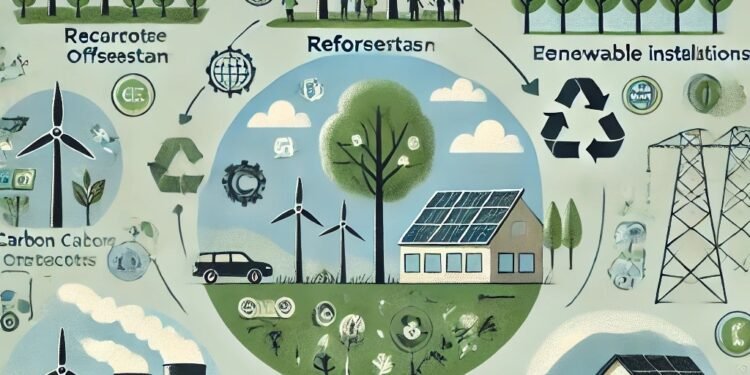Carbon offsetting projects are designed to reduce or remove carbon dioxide (CO₂) and other greenhouse gases from the atmosphere to compensate for emissions generated elsewhere. These projects play a critical role in the global effort to combat climate change by allowing individuals, companies, and governments to offset their carbon footprints. Below are examples of different types of carbon offsetting projects and their impact on the environment and communities.
1. Reforestation and Afforestation Projects
One of the most common types of carbon offsetting projects is reforestation and afforestation, where trees are planted to absorb CO₂ from the atmosphere. Trees act as natural carbon sinks, and large-scale tree planting efforts can remove significant amounts of CO₂ over time.
• Example Projects:
• Amazon Rainforest Restoration: Several projects focus on reforesting areas of the Amazon that have been cleared for agriculture or logging. By restoring these forests, CO₂ is sequestered, and biodiversity is enhanced.
• China’s Great Green Wall: A massive reforestation project aimed at combating desertification, the Great Green Wall initiative in China seeks to plant billions of trees across the country’s northern regions.
• Impact: Reforestation projects not only reduce CO₂ but also restore ecosystems, protect biodiversity, and provide social and economic benefits to local communities, such as employment in tree planting and forest management.
2. Renewable Energy Projects
Renewable energy projects are another important avenue for carbon offsetting. These projects replace fossil fuel-based energy generation with clean energy from sources like solar, wind, and hydropower. By displacing fossil fuels, renewable energy projects prevent CO₂ emissions that would otherwise occur.
• Example Projects:
• Solar Power in India: Projects that install solar panels in rural and urban areas in India help reduce reliance on coal-powered electricity, significantly lowering emissions.
• Wind Farms in Brazil: Wind energy projects in Brazil are helping to diversify the country’s energy mix and reduce its carbon footprint by replacing carbon-intensive energy sources.
• Impact: Renewable energy projects contribute to sustainable energy development, improve air quality, and enhance energy security. These projects also create jobs in clean energy sectors and promote technological advancements in energy efficiency.
3. Carbon Capture and Storage (CCS)
Carbon Capture and Storage (CCS) projects focus on capturing CO₂ emissions at the source—such as power plants or industrial facilities—and storing them underground in geological formations. This prevents CO₂ from being released into the atmosphere.
• Example Projects:
• Boundary Dam CCS Project in Canada: This facility captures CO₂ emissions from a coal-fired power plant and stores them underground, preventing millions of tons of CO₂ from entering the atmosphere.
• Sleipner CO₂ Storage Project in Norway: One of the longest-running CCS projects in the world, Sleipner captures CO₂ from natural gas production and stores it in a subsea reservoir.
• Impact: CCS projects can significantly reduce emissions from heavy industries and fossil fuel-based power plants, helping to mitigate the environmental impact of these sectors while still meeting energy demands.
4. Methane Capture Projects
Methane is a potent greenhouse gas that contributes to climate change. Methane capture projects focus on trapping methane emissions from sources such as landfills, wastewater treatment plants, and agricultural operations. The captured methane can be converted into renewable natural gas or used for electricity generation.
• Example Projects:
• Landfill Gas-to-Energy Projects in the U.S.: Methane emissions from landfills are captured and used to generate electricity, reducing the release of harmful gases and providing renewable energy.
• Biogas Plants in Europe: Agricultural waste, such as manure, is processed in biogas plants to capture methane and convert it into usable energy, reducing emissions from farming operations.
• Impact: Methane capture projects help prevent the release of a powerful greenhouse gas, improve waste management practices, and provide renewable energy to communities.
5. Community-Based Projects
Community-based carbon offsetting projects often focus on improving energy efficiency and promoting sustainable practices in local communities, particularly in developing countries. These projects can involve distributing clean cookstoves, improving water access, or providing energy-efficient appliances.
• Example Projects:
• Clean Cookstove Initiatives in Africa: Projects that provide cleaner and more efficient cookstoves to households in Africa help reduce CO₂ emissions from cooking with traditional biomass fuels like wood and charcoal.
• Water Purification Systems in Southeast Asia: By providing communities with access to clean drinking water through filtration systems, these projects reduce the need to boil water using firewood or coal, thereby cutting emissions.
• Impact: Community-based projects have dual benefits: they help reduce carbon emissions while improving the quality of life for local populations by providing cleaner air, reducing deforestation, and supporting sustainable livelihoods.
Conclusion
Carbon offsetting projects offer a practical and scalable way to reduce global greenhouse gas emissions. From reforestation and renewable energy projects to carbon capture and community-based initiatives, these efforts contribute to the global fight against climate change while providing environmental, social, and economic benefits. As more organizations and individuals seek to offset their carbon footprints, the impact of these projects will continue to grow, helping to build a more sustainable future.










































